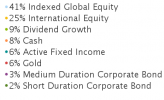Flybytheseat
Registered User
- Messages
- 244
I'll hopefully be in a position in 5 or less years to retire, take a lump sum and put a balance of circa €1M in an ARF. I'm hoping to go execution only on the ARF and would like to keep the overall AMC/TER on the fund in the region of 0.6% to 0.7%. I have a relatively high risk tolerance (ESMA 5.5). From various state and DB pensions I should have a guaranteed pension on top of the ARF of circa €23K pa.
From what I've read Zurich or Standard Life seem to offer the lowest Fund Manager charges of the Irish approved ARF providers. My current incling is to go with Zurich with the following asset allocation:
Portfolio Risk Rating 5
Portfolio Volatility 11.34%
Asset Split:
Cash
8.17%
Bonds
10.83%
Equity
75.00%
Commodity
6.00%
This is made up of the following Zurich funds:

I'm open to any feedback on my strategy or suggestions as to how to improve it.
Thanks in advance.
From what I've read Zurich or Standard Life seem to offer the lowest Fund Manager charges of the Irish approved ARF providers. My current incling is to go with Zurich with the following asset allocation:
Portfolio Risk Rating 5
Portfolio Volatility 11.34%
Asset Split:
Cash
8.17%
Bonds
10.83%
Equity
75.00%
Commodity
6.00%
This is made up of the following Zurich funds:

I'm open to any feedback on my strategy or suggestions as to how to improve it.
Thanks in advance.
Last edited: